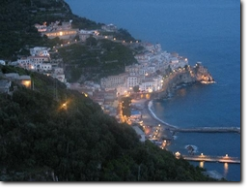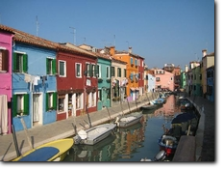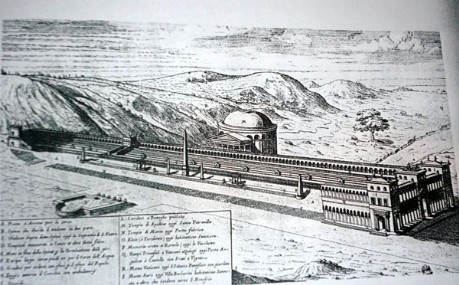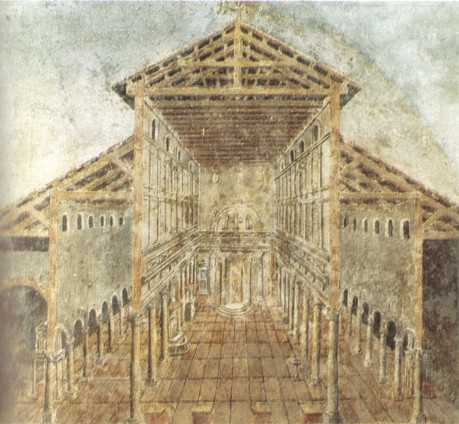The Vatican City | History of the Vatican | Vatican Museums | Rome Travels - Rome Travels | Home | Rome Guide | Rome Tours | Rome Travel | Religious Holidays | Italy Pilgrimages | Italy Shore Excursions




Main menu:
The Vatican City | History of the Vatican | Vatican Museums | Rome Travels
1. Vatican - Circus of Nero - St. Peter's Tomb - The Vatican Necropolis - The Basilica of Constantine

The term "Vatican" was used in ancient times to identify the swampy area on the right bank of the Tiber River. In the Roman period, at the time of both the Monarchy (753 - 509 B.C.) and the Republican Age (509 - 27 B.C.), the area was known as Ager Vaticanus. In the Imperial Age (27 B.C - 476 A.D.) the toponym Vaticanum was applied to an area corresponding roughly to the present Vatican City State. During the Roman period, several villas, the Agrippina’s gardens, Emperor Caligula's (37-41 A.D.) mother's house, coupled with a wide Circus and necropolis were built along the main roads - Via Cornelia and Via Trionfalis -. The Circus was later restored and enlarged by Nero (54-68 A.D.) the so called Circus Neronis .


The Apostle Peter received the martyrdom there being crucified up-side-down in the great Christian persecution ordered by Nero in 64 A.D. and he was buried right outside the Circus of Nero, along the Via Cornelia. Tons of unknown Christians had the same destiny along the centuries and were tortured in the same Circus of Nero.
Thus, many Christians, wished to be buried near the tomb of St. Peter and this became soon among the most significant destinations for Christian Pilgrims. The Vatican necropolis was partially levelled due to the construction of the basilica dedicated to the Apostle commissioned by the Emperor Constantine (306-337 A.D.) and ended during his reign. In the meantime Nero’s Circus was gradually falling apart, also because many of its stones were reused to build the church.

2. The Vatican in the Middle Ages: Pope Leo III - Charle Magne - The Avignon Captivity - The Vatican Permanent Residence of the Popes
Seven centuries later, the Emperor Charle Magne, great defender of the Roman Catholic Church, was crowned Emperor of the Holy Roman Empire on the Christmas Eve of 800 by Pope Leo III. He thought to secure the Vatican with city walls. In this way, few years later, Pope Leo IV (847-855) built the first city walls of the "civitas" which derived its name "Leonina": the so called Leo's City which became the spiritual centre of Medieval and Renaissance Rome.
In 1309 the Papal court was moved to Avignon (in France: the so called "Avignon captivity") and not only Rome itself but also St. Peter were totally abandoned for over a century. While the legal Popes were in France. In the meantime, two more "papacies" were created: the anti-popes in and/of Rome and the anti-anti-Popes of/in Pisa. Typically Italian....
Popes came back to Rome only in 1377 thanks to S.te Catherine of Siena and S.te Francesca Romana. They found their residence in the Lateran Palaces (St. John is still the Cathedral of Rome) totally sacked by the Romans and needed to move from there. Therefore, it is only in 1379 that the Popes started to reside in the Vatican.
A word to know: Circus
In Ancient Rome the Circus was a building for the exhibition of horse and chariot races, equestrian shows, staged battles, displays featuring trained exotic animals, jugglers and acrobats and other amusements.
3. The Vatican in the Renaissance: Pope Sixtus IV and the Sistine Chapel - Pope Julius II and Michelangelo - The Vatican Museums
The possibility of completely rebuilding St Peter’s was firstly approached the architect Rossellino whom, on behalf of Pope Nicholas V (1447-1455), drew up plans for enlarging the Basilica. Few years later, Pope Sixtus IV (1471-1492) restored the Palatine Chapel or Chapel of the Assumption and, on on 08/15/1483 inaugurated the great chapel, named "Sistina" (Sistine Chapel) after him, decorated with superlative frescoes done by the major Italian painters of the time (Botticelli, Perugino, Ghirlandaio, Pinturicchio).
Radical changes were carried out by his nephew, Pope Julius II (1503-1513), who started to pull down the Constantinian Basilica and edifying the new St. Peter’s Church. He also called Raphael and Michelangelo to Rome, asking them, respectively, to fresco the Papal apartments and the Sistine Chapel. Last but not least, he started the "core" section - the so called: "Cortile di Belvedere"- of what later bacame the greatest art collection in the world: the Vatican Museums. Four more Architects passed - among Bramante and Raphael - to erect the new Church. At the end, St. Peter's Basilica was planned and built by Michelangelo (mid-16th century). Della Porta and Vignola then vaulted the Dome in 1586 mainly according to the Michelangelo's plans. On the same year, Pope Sixtus V moved the Vatican Obelisk from its original place, in the center of the Circus of Nero (see the historical picture of the fresco abov ) to today's place, in St. Peter's Square.
4. The Vatican in the Baroque: Gianlorenzo Bernini and the triumph of the Catholic Church: the new St. Peter's Basilica
Related Link:
The Holy See
On the early 17th century the Church was enlarged by C. Maderno who also made the facade of the Church. Gianlorenzo Bernini won his impossible mission to accomplish: the decoration of St. Peter's Basilica. The Church which was formally inaugurated on St. Michael's day, protector of the Church, on 09/29/1626 after 120 years of construction. Marble, gold, over 3 acres of mosaics, stuccos, inlaid marble, granite: this was the Baroque in Rome and Rome and the Vatican had their main interpreter: GianLorenzo Bernini.
The Vatican complex was then completed again by G.L. Bernini on mid XVIth cent. designing the splendid and sumptous St. Peter's Square which was enclosed by two hemicycles of four rows of columns with 184 statues of the Saints on top.
5. From the Vatican State to the Vatican City State: The Lateran Pacts (1929) - The Vatican Today
The Vatican State corresponded more or less to what are today the Italian Regions of: Latium, Umbria, Marche and Romagna. By the time that Italy became an Independent and a unified country having Rome as the Capital of the new Kingdom of Italy (09-20-1870), the Vatican was suddendly lost all regions, including Rome. Officially it not exist anymore and was not recognized on the International Law. The Vatican and Italy started their political and diplomatic issues. For about 59 years the Vatican officially was not represented in the International Institutions as it lost its Political entity.
The Vatican City State was founded following the signing of the Lateran Pacts between the Holy See and Italy on February 11th 1929. These Pacts established the "Conciliation" between the two countries. Its nature as a sovereign State distinct from the Holy See is universally recognized under International Law. Since then, the Vatican City is the smallest independent State in the world in terms of inhabitants (rouphly 800) and size: it occupies an area of 44 hectares (109 acres). The borders are mainly represented by its walls and the the two wings of the colonnades in St Peter’s Square. Beyond the territory of the State, Vatican jurisdiction also covers some extraterritorial areas within and outside Rome: hospitals, universities, the Vatican Chancery, monasteries, the Papal Palace of Castelgandolfo, etc.

Related Link:
VaticanGuide.Com
Official Vatican
Tour Guide
6. The Vatican Museums - The Museums of the Popes
The Vatican Museums in 2006 celebrated its fifth centenary of history, being originated as a private group of sculptures collected by Pope Julius II (1503-1513) and stored in what today is the “Octagonal Courtyard” . It is quite significant that their very first piece of Art, the Laocont Group, entered on purpose officially on the Valentine Day of 1506, birth date of the Vatican Museum. Since the beginning, the Vatican "Spouse" has always been Art.
The popes did not open their magnificent palaces to the ordinary public that until after February 11th 1929, the foundation date of the Vatican City State (see above). Until then, the Vatican Museum was only reserved to dignitaries, nobles and kings.
As of today, inside the Vatican there are a complex of several pontifical galleries that began essentially through two popes, Clement XIV (1769-1774) and Pius VI (1775-1799) who created the enchanting Pio - Clementine Museum, named after these two popes.
Later on, Pius VII (1800-1823) extended the collections of antiquities, once so many sculptures came back from the Louvre after the Congress of Vienna (1815), by the addition of the Lapidary Gallery, the Chiaramonti Museum (1809) and the “Braccio Nuovo” Museum (1822).
Pope Gregory XVI (1831-1846) founded not only the Etruscan Museum (1837) with its archaeological treasures found in the outskirts of Rome (Cerveteri & Tarquinia) and the Egyptian Museum (1839), but also the Lateran Profane Museum (1844). This museum was then enlarged thanks to Pius IX (1846-1878), who created also the Pio Christian Museum in 1854. This unique museum has the world largest collection of engravings expressing the stories of the Holy Bible (particularly in the sarcophagi) and inscriptions with Early Christian context. St. Pius X (1903-1914) founded here the Hebrew Lapidary with hundreds of inscriptions from the ancient Jewish cemeteries in Rome (particularly from via Portuense & Trastevere Area).
These last collections (Gregorian Profane Museum, Pio Christian Museum and the Jewish Lapidary) were moved in 1970, under the pontificate of Pope John XXIII (1958-1963), from the Lateran Palace to their present building within the Vatican City State.

Vatican Meridien - Tower of The Winds
The Vatican Museums today also include the Borgia Apartments, where the Spanish Pope Alexander VI lived (1492-1503).
The Vatican Painting Gallery, created by Pius XI (1922-1932), the first building created once the Vatican Museum was open to the visitors.
The enchanting Chapel of Nicholas V (1447-1455), painted by Fra' Angelico and describing the histories of St. Lawrence and St. Steven.
Of course the Sistine Chapel, named after its re-founder, Pope Sixtus IV, who created also the Vatican Apostolic Library (1471).
The three Upper Galleries include the Gallery of Candelabras (by Pope Leo XII, 1896), the Gallery of Tapestries, dating from the 15th and 17th centuries & the Gallery of Maps, decorated during the pontificate of Gregory XIII (1572-1585) and embellished by Urban VIII (1623-1644); The Sobieski Room created on late XIX cent. and the Room of the Immaculate Conception.
The Lower Galleries include the as the Sistine Room, the old reading room of the Apostolic Library created by Pope Sixtus V (1585-1590).
The Vatican Museums are inclusive as well of the magificient Raphael Rooms and the Loggia, which were decorated by order of both Julius II and Leo X (1513-1521) by Raffaello Sanzio, the Renaissance Casina of Pius IV (1560-1565), today visible in the Vatican Gardens; The Missionary-Ethnological Museum, founded by Pius XI in 1926 and later moved under Pope John XXIII (the Good Pope) to the Vatican Museums.
In 1973 the Collection of Modern and Contemporary Religious Art was added and inaugurated by Pope Paul VI (1963-1978) in the Borgia Apartments.
The Vatican Historical Museum, founded in 1973 and transferred in the Lateran Palace, holds several Popes' portraits along with stupendous Tapestries (best ones) plus several objects of the previous Pontifical Military Corps and of the Papal ceremonies.
Last, the Carriage and Automobile Museum (Carriage Pavilion) is the last Museum added in the Vatican City State.
In the year 2000, the Vatican Museums opened a new large and modern entrance thanks to the unforgotten John Paul II (1978-2005) which serves better the standard of a modern Museum.
Have a good visit with us !
Cristiano Pellegrini - Rome Travels S.r.l.

